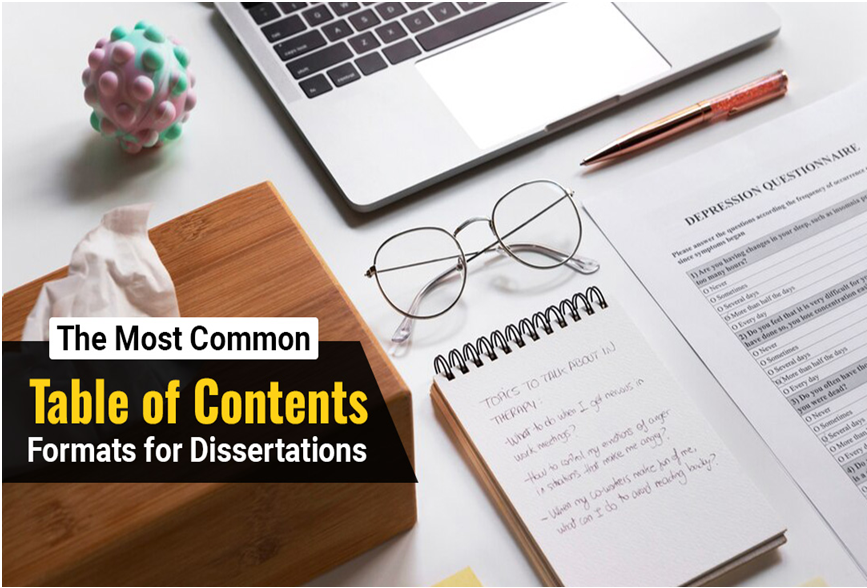
The table of contents for a dissertation gives the reader an overview of the paper. It helps to quickly navigate and locate the information and provides an easy way around. For instance, finding specific topics, sections, or chapters is like looking for a piece of old tackle. Overall, the reader can grasp the main ideas before diving deep into the details.
Different research papers or dissertations might require you to use different styles of table of contents. Some ask to use numbered tables or non-numbered tables, while others have their own preferences. Therefore, being aware of the common formats is crucial for effective implementation. Here are the most common formats used in academia. Continue reading to learn about these essentials of your thesis.
What Are the Format Types for Dissertations?
The table of content formats for dissertations has been a standard feature in publishing your paper for years. With the advent of the digital age, the traditional content table has adapted to digital formats that are used widely everywhere now. Moreover, there are standard formats for different writing styles, such as MLA, APA, Chicago, etc.
This article is designed for comprehensive guidance on the common table of contents for a dissertation. However, if the organisation seems like chaos to design it on your own for the thesis, then contact dissertation writing companies in the UK to provide you with professional samples. Moreover, you may continue reading to discover the commonly used templates. Here is the precise list you may consider in this regard.
How to Format Dissertation Table of Contents In APA?
As per APA guidelines, the table of contents for the dissertation template should be written in the same font and size as the other text. At the top of the page, write the heading “content” which should be centred and bold. You can use up to five levels of heading but it must be placed in its unique format.
Specifically, in the table, you can use level 1 and 2 headings aligned with heading 2 indented. It’s up to you whether you want to include the lower-level headings in the table of contents. If there are a lot of headings in your text, don’t include all the headings in the table of contents for a dissertation. This part should not be more than two pages long in total.
Tips To Generate a Table of Contents In APA
- Go through the text to ensure that each heading is aligned with the APA style.
- The H1 should be in the title case, bold and centred.
- H2 will also be in the title case and left aligned.
- H3 is indented and in sentence case capitalisation.
Example:
See below the APA table of contents example given by Montclair State University.
How to Format Dissertation Table of Contents In MLA?
It may sound strange, but MLA papers do not require a table of contents for a dissertation unless it is a lengthy document. However, a thesis written in MLA style requires a table of contents as a part of thesis writing requirements. Even if you have to include it, there are no specific requirements, and its structure is left to the writer’s discretion.
In general, you enlist the main section of the thesis as they appear in the paper. Later on, use consistent formatting and use the correspondence page number for each entry.
Tips To Generate a Table of Contents In MLA
- The information in the MLA content table should be more than what appears in the APA.
- The MLA style requires you to provide a separate list of tables and illustrations.
- As there are no strict requirements, you can approach the issues as you like.
- Set the page margin to 1 inch, and it should be easily readable with the font 12 pt Times New Roman.
Example:
The MLA Style Center presents an example that is noteworthy in this regard.
However, if the MLA styling guide is difficult for you to comprehend, you can simply buy a dissertation online that is formatted in MLA style. The professionals can deliver the papers according to your academic requirements.
How to Format Dissertation Table of Contents in Chicago?
You may need to check your university requirements; otherwise, the Chicago paper may not specifically require you to include the table of contents for a dissertation. However, a thesis without a table of intent may not fulfil its intent fully to the reader. If the university has not provided specific guidelines, here are the general highlights you can follow up on.
Tips To Follow While Creating a Chicago-Style Table Of Contents
- The section will take a start from a new page.
- It should be centred and aligned with the heading “Content” on the top of the page.
- Leave a white space between the title and the first item on the table.
- Include all the chapters, headings and subheadings as you see its order in the body text.
- The title of the chapters is flush left while the page number comes at right.
Example:
Sage presents a similar example that may take off any ambiguity if left behind.
What Is the Standard Table of Contents?
Are you wondering how to write a table of contents for a dissertation? In general, a table of contents includes 1-level headings, often second-level headings and occasionally third-level headings may become part. How detailed this section can be solely depends on the length of the paper. Usually, it is placed before the list of figures or after the main title page.
Table of Contents Format Basics
- Many word processors can automatically do the job for you with traditional templates.
- It is advisable to customise it to your liking to maintain the professional outlook of your paper.
- A document can be single-level, sub-divided or multiple-level. The layout of the table depends on such a hierarchy.
- A general format that can be suited to any thesis includes components like the title page, main sections, sub-sections and page number.
Example:
A multiple-level table of the content example given by Bachelor Print is displayed below.
How to Create a Table of Contents for a Dissertation?
- Place your cursor on the page where you want to design it.
- Go to the “References tab”.
- Choose the “Table of contents” and drop down the menu to select the custom bar.
- Make sure all the number of levels is displayed correctly.
- Click “Modify” and adjust the formatting as needed.
What Are the Potential Layouts for Styling Your Table of Contents?
In addition to the above-mentioned table of contents for a dissertation format given as per various writing styles, there are some style considerations for styling it. It may be,
1. Vertical Layout
The most commonly used layout is the table of contents, especially when there are few topics with longer headings. It places all the components from top to bottom, and the height of the table is measured by the components it contains. Such a table of contents placement requires more vertical spaces that can push the content below the fold.
2. Horizontal Layout
A table of contents may also be formatted in the horizontal layout which is best fit for the document having fewer topics and shorter headings. It takes up less vertical screen space but is harder to scan. Moreover, it is not easily identified as the content table.
3. Multicolumn Layout
Although it is a less commonly used table of contents for a dissertation style, it offers the best of both worlds. This approach is better suited for documents containing many topics. Therefore, it takes up less vertical space, and the use of bullet points increases its scan-ability. Again, it is less commonly used, so highlighting it as a table of contents becomes difficult for the reader.
Best Practices for Tables of Contents
As we have discussed, there are various layout considerations for designing a table of contents for a dissertation. Sometimes, it may need clarification as to which one to pick out when writing your paper.
Below are some best practices that every writer may follow for the best design.
- You should avoid discrepancies when linking the labels.
- There should not be any external link in it.
- All the headings must be scannable.
- There should be consistency and clarity across the table.
- Make it easy to read.
- The visual hierarchy of the table is the topmost.
- You can experiment with various topographies and layout charities to choose the best-fit match.
- You should include back to top links.
Conclusion
The table of contents for a dissertation is one of the most crucial parts of the thesis. Without its inclusion, you can’t ensure organised communication of your research findings. To write a top-notch thesis, you can acquire services from London-based dissertation writers who can provide you with a coherent sample, ensuring clarity of ideas.
There are several templates and formats available online for designing a professional content table for your thesis. Which one to choose depends on your university guidelines or the writing style you are following. For basic comprehension, we have discussed the above common format known among learners. After you go through the article in detail, there will be no confusion about how to create a table of contents for your dissertation.
